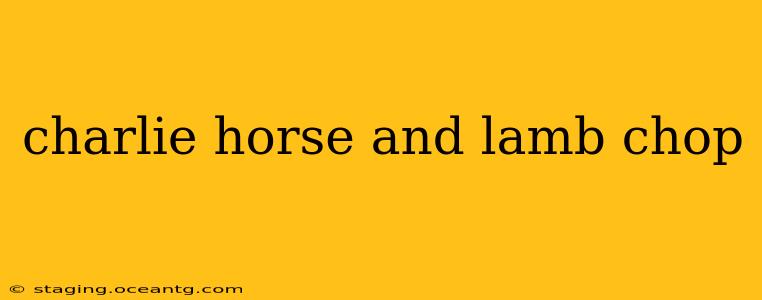The terms "Charlie horse" and "lamb chop" might seem completely unrelated at first glance. One evokes a painful muscle cramp, the other a delectable culinary treat. However, exploring both terms reveals interesting facets and, surprisingly, some subtle connections in terms of popular culture and common usage. This article will delve into the meaning, origins, and cultural significance of each, addressing common questions along the way.
What is a Charlie Horse?
A Charlie horse is a sudden, involuntary, and often painful muscle cramp. It's typically characterized by a tightening or shortening of the muscle, resulting in a hard, knot-like sensation. These cramps can occur in any muscle group, but are commonly experienced in the legs and feet, particularly after intense exercise or prolonged periods of inactivity. The pain can range from mild discomfort to excruciating agony, depending on the severity and location of the cramp.
Why is a muscle cramp called a Charlie horse?
The origin of the term "Charlie horse" remains somewhat mysterious, with several competing theories. One popular theory suggests it's derived from "charley," a slang term for a horse, with the implication that a muscle cramp feels like a horse kicking internally. Another suggests it originates from early baseball slang, potentially referencing a player named Charley who was known for his powerful kicks or leg injuries. The exact etymology remains debated, highlighting the richness and evolution of language.
What causes Charlie horses?
Several factors can contribute to the development of Charlie horses. These include:
- Dehydration: Loss of electrolytes (like sodium and potassium) through sweating can disrupt muscle function and trigger cramps.
- Muscle fatigue: Intense physical activity can lead to depletion of energy stores and electrolyte imbalances, predisposing muscles to cramps.
- Lack of stretching: Inadequate stretching before and after exercise can contribute to muscle tightness and increase the risk of cramps.
- Certain medical conditions: Conditions like hypothyroidism, kidney disease, and peripheral artery disease can increase the susceptibility to muscle cramps.
- Medications: Some medications, as a side effect, can also increase the likelihood of developing muscle cramps.
How do you treat a Charlie horse?
Fortunately, most Charlie horses are relatively short-lived and can be treated effectively using simple home remedies:
- Gentle stretching: Gently stretching the affected muscle can help relieve the cramp.
- Massage: Massaging the cramped muscle can help to relax it and alleviate pain.
- Hydration: Replenishing lost fluids and electrolytes through water and sports drinks can prevent future occurrences.
- Heat or ice: Applying heat or ice to the affected area may provide some pain relief.
What is a Lamb Chop?
A lamb chop is a cut of meat from a lamb, typically taken from the rib or loin section. Lamb chops are known for their tender texture and delicate flavor. They are a popular choice for grilling, pan-frying, or roasting, and can be prepared in countless delicious ways. Their versatility makes them a staple in many cuisines worldwide.
What's the difference between lamb chops and mutton chops?
The difference lies primarily in the age of the animal. Lamb chops come from lambs that are less than one year old, while mutton chops come from sheep that are older than one year. Mutton tends to be tougher and more strongly flavored than lamb.
How are lamb chops prepared?
Lamb chops are remarkably versatile. They can be:
- Grilled: Grilling imparts a smoky char and enhances the natural flavors.
- Pan-fried: Pan-frying allows for quick cooking and excellent browning.
- Roasted: Roasting produces tender, juicy chops with a rich flavor.
- Broiled: Broiling provides a quick and easy cooking method.
What are some popular lamb chop recipes?
There is a world of lamb chop recipes available, from simple seasoning and grilling to more complex marinades and sauces. Many recipes incorporate herbs like rosemary and thyme, complementing the lamb's flavor profile.
In conclusion, while seemingly disparate, "Charlie horse" and "lamb chop" each represent interesting aspects of language, culture, and culinary experiences. Understanding their origins and usage provides a glimpse into the rich tapestry of human expression.
